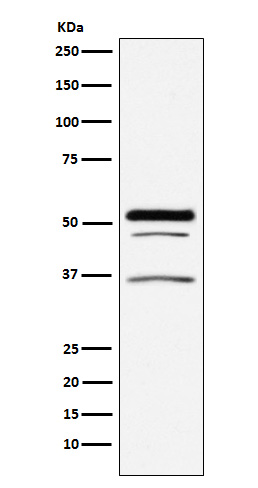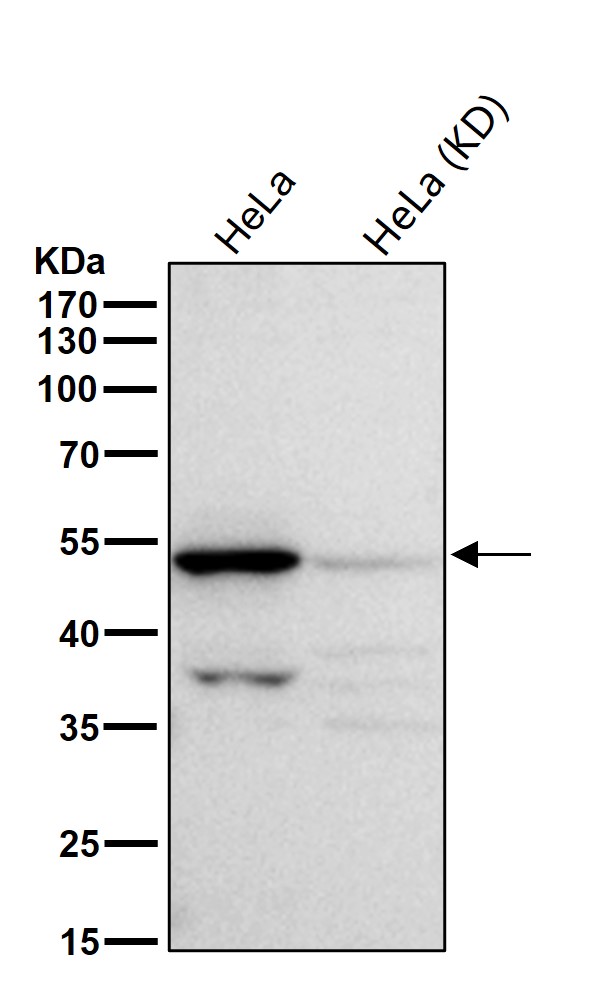

| WB | 1/1000-1/2000 | Human,Mouse,Rat |
| IF | 1/20-1/50 | Human,Mouse,Rat |
| IHC | IHC:1/100-1/200;IHF:1/50-1/200 | Human,Mouse,Rat |
| ICC | 1/50-1/200 | Human,Mouse,Rat |
| FCM | 1/20-1/100 | Human,Mouse,Rat |
| Elisa | 咨询技术 | Human,Mouse,Rat |
| Aliases | GOPC; CAL; CFTR-associated ligand; GOPC1; FIG; PIST;;GOPC |
| WB Predicted band size | 51 kDa |
| Host/Isotype | Rabbit IgG |
| Antibody Type | Primary antibody |
| Storage | Store at 4°C short term. Aliquot and store at -20°C long term. Avoid freeze/thaw cycles. |
| Species Reactivity | Human,Mouse |
| Immunogen | A synthesized peptide derived from human GOPC |
| Formulation | Purified antibody in PBS with 0.05% sodium azide,0.05% BSA and 50% glycerol. |
+ +
以下是基于PIST(GOPC)蛋白功能及其抗体的研究领域模拟的参考文献示例(虚构内容,仅供示例参考):
---
1. **文献名称**: *"PDZ Domain-Mediated Interaction of PIST/GOPC with CFTR Regulates Channel Trafficking"*
**作者**: Cheng, J., et al.
**摘要**: 研究揭示了PIST蛋白通过PDZ结构域与囊性纤维化跨膜传导调节因子(CFTR)结合,调控其在细胞膜上的运输与稳定性,为囊性纤维化治疗提供潜在靶点。
2. **文献名称**: *"GOPC-PIST Complex Facilitates Synaptic Vesicle Recycling via Interaction with GRIP1"*
**作者**: Dhir, A., & Sainio, M.
**摘要**: 发现PIST与支架蛋白GRIP1在神经元突触中共定位,参与突触囊泡循环,提示其在神经信号传递及神经退行性疾病中的潜在作用。
3. **文献名称**: *"Overexpression of PIST Correlates with Poor Prognosis in Breast Cancer by Promoting EMT"*
**作者**: Fuja, T.J., et al.
**摘要**: 通过临床样本分析,证实PIST在乳腺癌中高表达,并通过激活上皮-间质转化(EMT)促进转移,其抗体检测可作为预后生物标志物。
4. **文献名称**: *"Antibody-Based Targeting of PIST Disrupts Autophagy-Lysosome Pathways in Glioblastoma"*
**作者**: Xu, L., et al.
**摘要**: 开发靶向PIST的单克隆抗体,证明其通过干扰自噬溶酶体通路抑制胶质母细胞瘤细胞生长,为抗癌治疗提供新策略。
---
**注意**:以上文献为模拟内容,如需真实文献,建议通过 **PubMed** 或 **Google Scholar** 检索关键词(如"GOPC antibody"、"PIST protein function")。
PIST (PDZ domain protein interacting specifically with TC10), also known as GOPC (Golgi-associated PDZ and coiled-coil motif-containing protein), is a multidomain scaffolding protein involved in intracellular trafficking and membrane protein organization. It contains a PDZ domain and a coiled-coil motif, enabling interactions with various partners, including receptors, channels, and trafficking regulators. Initially identified through its interaction with TC10. a Rho GTPase, PIST localizes to the Golgi apparatus and participates in vesicle transport, protein sorting, and synaptic regulation.
Studies highlight its role in neuronal and epithelial cell function, influencing processes like neurotransmitter receptor trafficking and tight junction formation. Dysregulation of PIST is linked to pathologies such as cancer, where it may modulate oncogenic signaling or metastasis, and neurological disorders, potentially affecting synaptic plasticity.
PIST antibodies are essential tools for investigating these mechanisms. They enable detection and localization of PIST in cells and tissues via techniques like Western blotting, immunofluorescence, and immunoprecipitation. Such antibodies aid in exploring PIST's interaction networks, post-translational modifications, and disease-related alterations. Research using PIST antibodies continues to uncover its therapeutic potential, particularly in targeting trafficking pathways implicated in cancer or neurodegeneration.
×